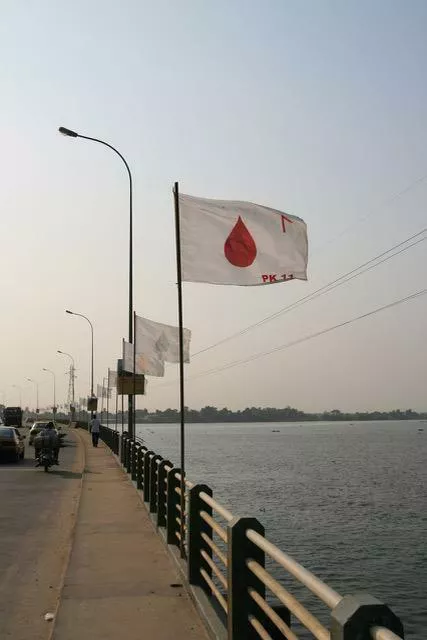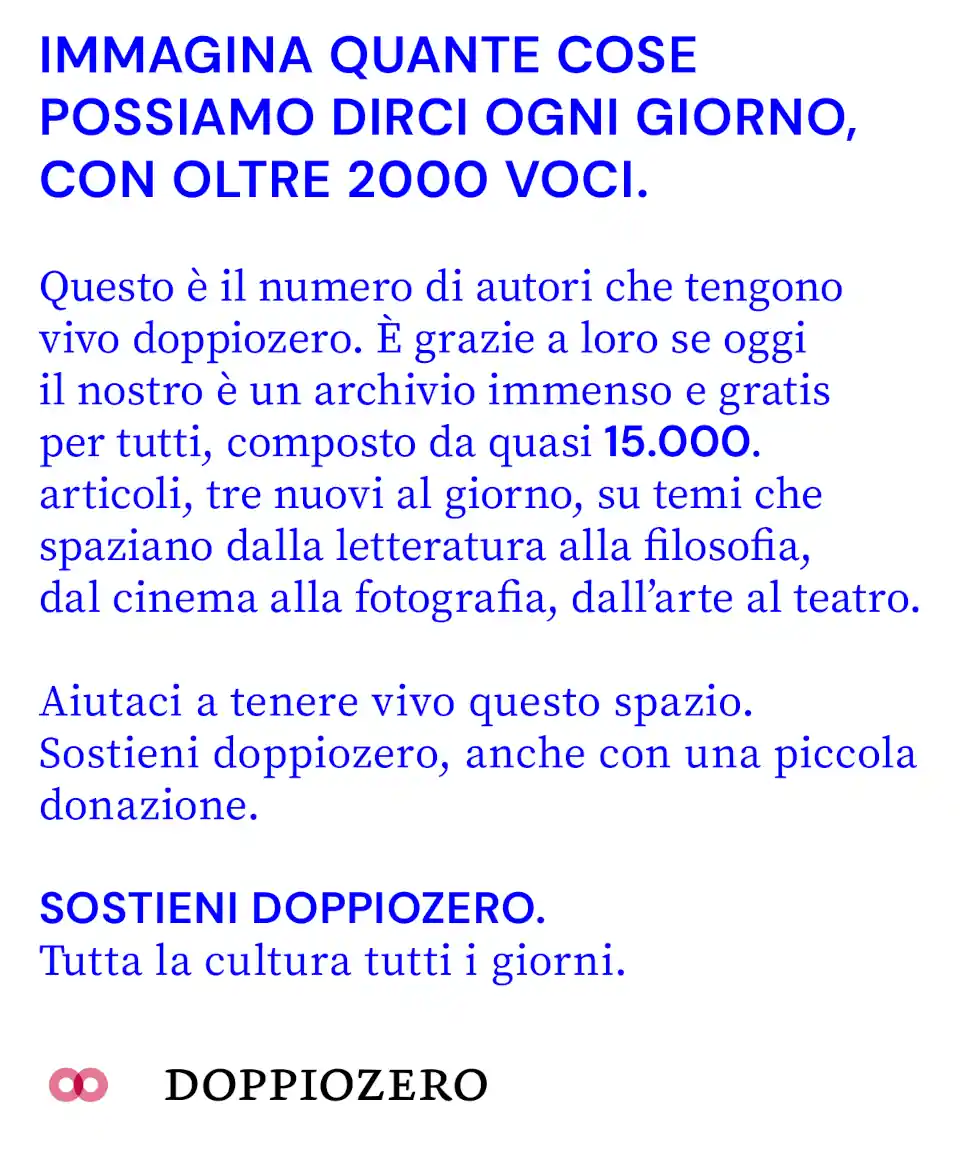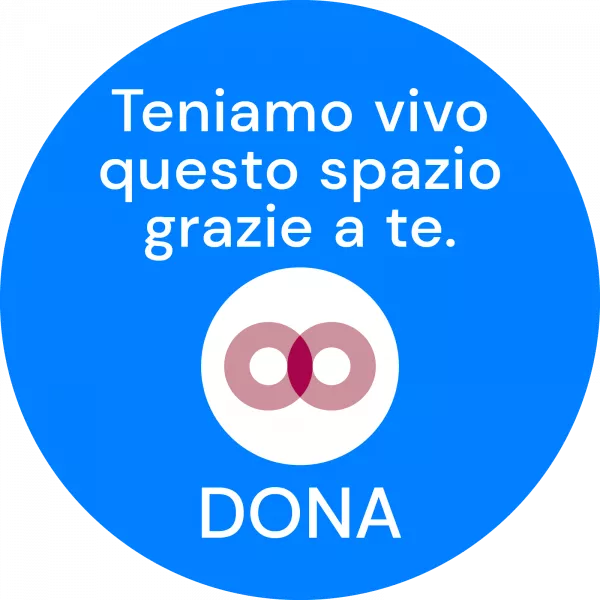Speciale
Making Douala 2007-2017
A small structure spread over three stories, with flooring bordered by rows of seedlings running along the balustrades, all nourished by an irrigation system that collects rainwater and distributes it drop by drop. Each drop falls against metallic cans and produces a musical note, creating a delicate and harmonic sound. Lucas Grandin's The Sound Garden of Bonamouti (Le Jardin Sonore de Bonamouti) rises a little higher than the Wouri River in Douala, a large city in Cameroon. Surrounding it is a lawn, finally clean. When the artist arrived in the area in 2010, it resembled a landfill dump. Convincing the inhabitants to clear the terracing overlooking the water, in a setting that seemed potentially fascinating, was not easy: Grandin rolled up his sleeves and began to remove tires, plastic, garbage, by himself. Slowly one after another joined him.
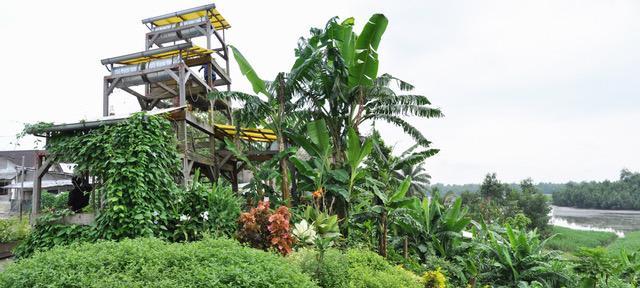
Lucas Grandin, Le Jardin Sonore de Bonamouti, 2010. Credits doual'art.
Recognizing that an abandoned space can become a shared space is not really obvious in the context of an area like Douala, where a large part of the population lives in informal settlements with no roads and few spaces of conviviality. Perhaps you've been living in the neighborhood for decades, yet still without the legitimacy of land occupancy. Since the end of the colonial period, land ownership has become the subject of controversial disputes between the state, historic land owners, and new entrepreneurs. Consequently, poorer communities experience a tangible and permanent risk of being removed from their lands from one day to the next. Services, if any, are lacking. Rainfall causes cyclical flooding. Even the police do not intervene when called, leaving families at the mercy of the gangs and bandits. And here, where the population lives in extreme misery, even the theft of small items is enough to toss to the wind the fragile economy of an entire family.
Seven years later, the dump has not returned. In the morning, The Sound Garden is frequented by fishermen, in the evening by youth who make dates to enjoy a bit of shade and the river view accompanied by the sweet sound of the drops of water. Here is truly a public space, appropriately shared by those who are taking care of it today.
Lucas Grandin's installation was produced under SUD - Salon Urbain de Douala, a triennial cultural event that brings both Cameroonian and international artists to the poorest neighborhoods of Douala, producing contemporary public art for the city, to the backdrop of a weeklong celebration full of concerts, performances, screenings, and conferences. The festival is organized by doual'art, an art center in Douala founded in 1991 by Didier Schaub and Marilyn Douala Manga Bell, in collaboration with ICU art projects and Lucas Grandin. Public artworks are generally developed after the artists have resided for a period of time in the district for which the project is destined; they are the result of complex interactions and negotiations. Only in this way is it possible to create the conditions for interventions that make sense to the community, and which in fact transform it.
Where land ownership is unclear, and in the absence of social and institutional structures for reference, artists – with the support of doual'art – have to engage in complex negotiations in order to work, a participatory process that initiates a new perception of self in the community and an increased awareness of shared interests. In some cases, the effects are lasting and have a structuring impact, causing the population to organize themselves. It happened in the district of Bessengué where, following the production of workshops, along with a fountain, bridge, and radio station, a group of people took the initiative, turned to the World Bank and obtained funding.
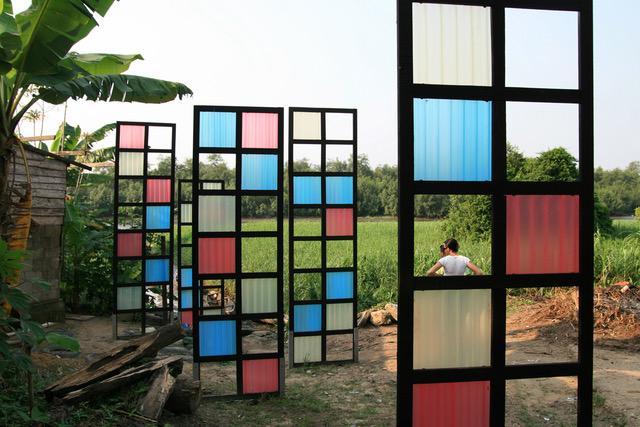
Salifou Lindou, Face à l'Eau, 2010. Credits Sandrine Dole
The SUD experience is now being told in an exhibition, which runs until July 9, 2017 at the Ausstellungsraum Klingental gallery in Basel. Organized by doual'art, ICU art projects & Lucas Grandin, and the University of Applied Sciences and Arts of Italian Switzerland (SUPSI), and with the support of the Agora program of the Swiss National Science Foundation, "Making Douala 2007-2017" also anticipates projects that will be presented during the next triennial edition, scheduled for December 5 to 10 of this year. It is a documentary exhibition with models, videos, posters, sketches and photographs of the public artworks made in Douala. The exhibition brings a fragment of Douala’s chaotic vitality to the highly-ordered Basel. It does so through a new work by Italian artist Roberto Paci Dalò, who created the installation Douala Flow: a visual representation of how the relationship between the business and cultural activities present in the physical city and their online representation has evolved through time (the oral culture is still dominant in Cameroon today), through the use of the voices of Douala radio personalities and interviews collected in the research that inspired Paci Dalò.
In addition to documenting the works, "Making Douala 2007-2017"– with its constantly updated exhibit – also summarizes the results of a research project launched by the lettera27 foundation and headed by SUPSI. The project draws from the extraordinary experience of Douala (a rarity, not just in Africa, for the longevity, systematic approach, amplitude and quality of interventions) to investigate its impact on security. It is common to measure security by using crime-related indicators. “Mobile Access to Knowledge: Culture and Safety in Africa. Documenting and assessing the impact of public art and cultural events on urban security” (which also related the vastly different experiences of Luanda in Angola and Johannesburg in South Africa) reorganizes the theme of security in a new way, also considering the related factors of livability, social cohesion and civil cohabitation: a well-kept public space, where residents feelownership and recognition,is in fact a safer public space.
In this sense, the impact of SUD, and more generally the work carried out by the art center doual’art in Douala since the nineties, has been remarkable. With the involvement of artists, monumental works and structural-functional works (such as fountains, wells, and bridges) have been produced, along with works of a more poetic-decorative nature. Land ownership has been a significant variable for predicting the reaction to artistic interventions by the citizens: thus it appears that works established in open spaces such as streets or squares, disconnected from residential use, are perceived as governmental statements and more easily subject to complaint. This was the situation with two remarkable monumental sculptures: Joseph-Francis Sumégné's La Nouvelle Liberté, an imposing and grotesque human-like sculpture made of metallic waste material which, despite the initially negative reception, is now a symbol of the city of Douala; and Pascale Marthine Tayou’s La Colonne Pascale (Pascale’s Column), a very tall and thin column composed of pots stacked one on the other. A gentle, joyous tribute to women in the intentions of the artist, with great evocative power for visitors, whose construction has however provoked a strong controversy among the inhabitants who felt offended by the authorities (despite the production of this work, like that of Sumégné, being attributed to doual'art), because in their eyes the column represented their condition of perennial hunger.
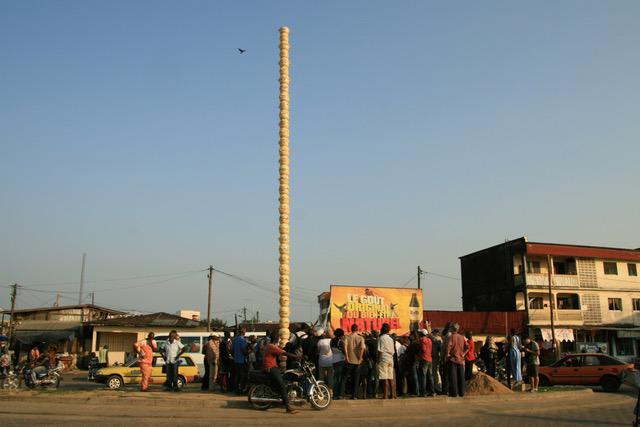
Pascal Marthine Tayou, La Colonne Pascal, 2010. Credits Sandrine Dole
Another category of works presented extensively in Douala is that of the structural interventions positioned close to marginalized communities. The citizens appreciate their functionality, regardless of their artistic value, which is not necessarily acknowledged. In addition to solving practical problems, their contribution has also been significant in social terms, because they provide a sense of care for public space that promotes well-being and therefore security. Examples of this are The Small Bridge (Le Passerelle) of Bessengué by Alioum Moussa, in which a bridge connects two districts; The Borne Fountain, by Cameroon architect Danièle Diwouta-Kotto, which provides public access to clean water; or New Walk Ways in New Bell, wood panels that Kamiel Verschuren placed to cover sewer pipes, with words inscribed dedicated to water, a valuable resource that is constantly at risk in Douala.

Kamiel Verschuren, New Walk Ways in New Bell, 2010. Credits Kamiel Verschuren
However, the most influential in terms of identity, pride, and sense of belonging are those works placed in highly-frequented areas. They have a poetic character, and pay tribute to the inhabitants of a neighborhood. An example is Hervé Yamguen's Les Mots Écrits de New-Bell, with words written by local rappers reproduced in neon light, or the festively wild garden painted by Tracey Rose in the courtyard of a school (Oasis).
The artistic quality of the works, documented in detail in the informative catalog accompanying the exhibition (Public Art in Africa, by Iolanda Pensa, Metis Presses 2017, which also includes a series of paper and online essays produced in SUPSI’s field research) is remarkable. But the most striking impact that doual'art and the triennial SUD activities have is on the city and its inhabitants. A process of integration, legitimization, return of dignity to the most marginalized population from which many can learn, not only in Africa but also in the poorer neighborhoods of the West. A Douala teacher sums it up best: "What a réveille!" Public art awakens.
Translation by Laura Giacalone
Making Douala 2007-2017, Travelling exhibition Triennial SUD - Salon Urbain de Douala: addressing public space in the city of Douala, Cameroon organized by doual’art, ICU art projects & Lucas Grandin, and SUPSI at AusstellungsraumKlingental, Basel, until July 9, 2017, http://ausstellungsraum.ch/. Public Art in Africa. Art and Urban Transformations in Douala, by IolandaPensa, Metis Presses, 2017 SUD 2017, The Human Dimension, Douala, December 5-10, 2017 http://www.doualart.org
